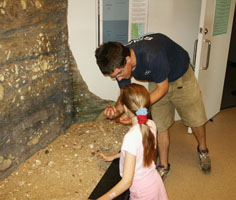Classroom Resources:

Teaching evolution can be a challenge, but help is available.
Below are a links to web sites that I have found to be very
helpful in teaching evolutionary theory. Each
link is followed by a brief description of the web site subject matter,
and its potential as a resource for teachers.
| Back |
Evolution
101 Berkeley Museum (http://evolution.berkeley.edu/evosite/evo101/index.shtml)
This web site is the Berkeley Museum of Paleontology's learning
resource
center, and consists of an online module of lessons surrounding the
ideas of evolution and evolutionary science. While this module is
accessible, well designed, and fun to use, it lacks the ability for a
teacher to asses prior misconception and the ability to easily navigate
to lessons or exercises that can be used in a classroom setting.
This web site is good for people to look up information on evolution,
however it lacks the assessment and support for direct classroom
application.
The Evolution and Nature of Science
Institutes (ENSI) Lesson Plans (http://www.indiana.edu/~ensiweb/evol.fs.html)
This web site was designed around the belief that in order for
evolution to be properly understood as a science a substantive
introduction to the nature of modern science is a necessary
prerequisite. The sixty plus lessons on this site reflect this
ideal, as they provide lesson plans for 6-12th grade educators on a
wide variety of evolutionary topics.
Teaching Documents about
Evolution (http://www.uni-wuerzburg.de/mineralogie/palbot/teach/evolutionteach.html)
This web site consists of hundreds of links for teachers. The
focus of the web site is on teaching documents on
evolution, but numerous other topics are present. This site
contains links to professional articles, studies, and lesson
plans. It is a good resource for teachers looking for ways to
spruce up lesson plans, but lacks any direct classroom
application.
The Caminalcules, an evolutionary
exercise (http://taxonomy.zoology.gla.ac.uk/~rdmp1c/teaching/L4/Evolution/Session2/cam.html)
The Caminalcules are artificial animals created by the late Professor
Joseph Camin of the University of Kansas as part of a study of how
taxonomists classify real organisms. Teachers can download the
worksheets can use the Caminalcules to explore the problem of
classification, with emphasis on using the principle of parsimony to
find the best system. Caminalcules of various ages can be used to
construct a phylogenic tree. Very effective classroom exercise
and one
that will be incorporated in to my teaching module.
The National Academy of
Science
(http://www.nationalacademies.org/evolution/)
This web page is designed to provide easy access to books, position
statements, and additional resources on evolution education and
research. These materials have been produced by the National Academy
and other sources. The site is updated and expanded periodically.
This web site appears to be a very effective resources for background
on
the best practice for teaching evolution.
And Still We Evolve.., exerts from "A Handbook on the
History of Modern Science"
(http://www.mala.bc.ca/~johnstoi/darwin/sect2.htm)
This web page consists of exerts from a handbook prepared by Ian
Johnston of Malaspina University-College, Nanaimo, BC, for Liberal
Studies students. This chapter, "The Early Development of Modern
Geology" is a in depth look on the history of geological science and
the origin of the great debate between science and religion. Good
supplemental background for upper level science classes looking to
examine the historical underpinnings of modern geological theory.
